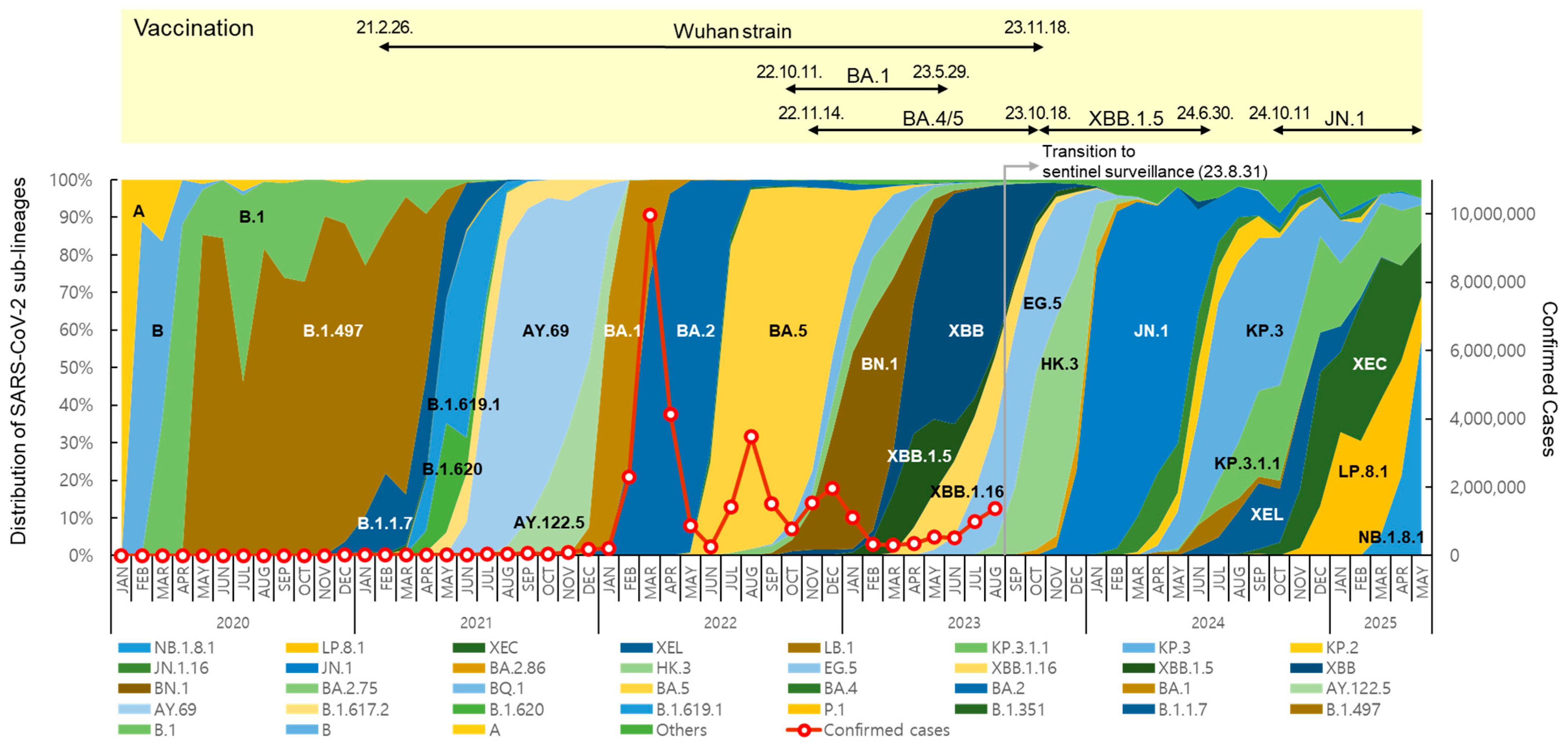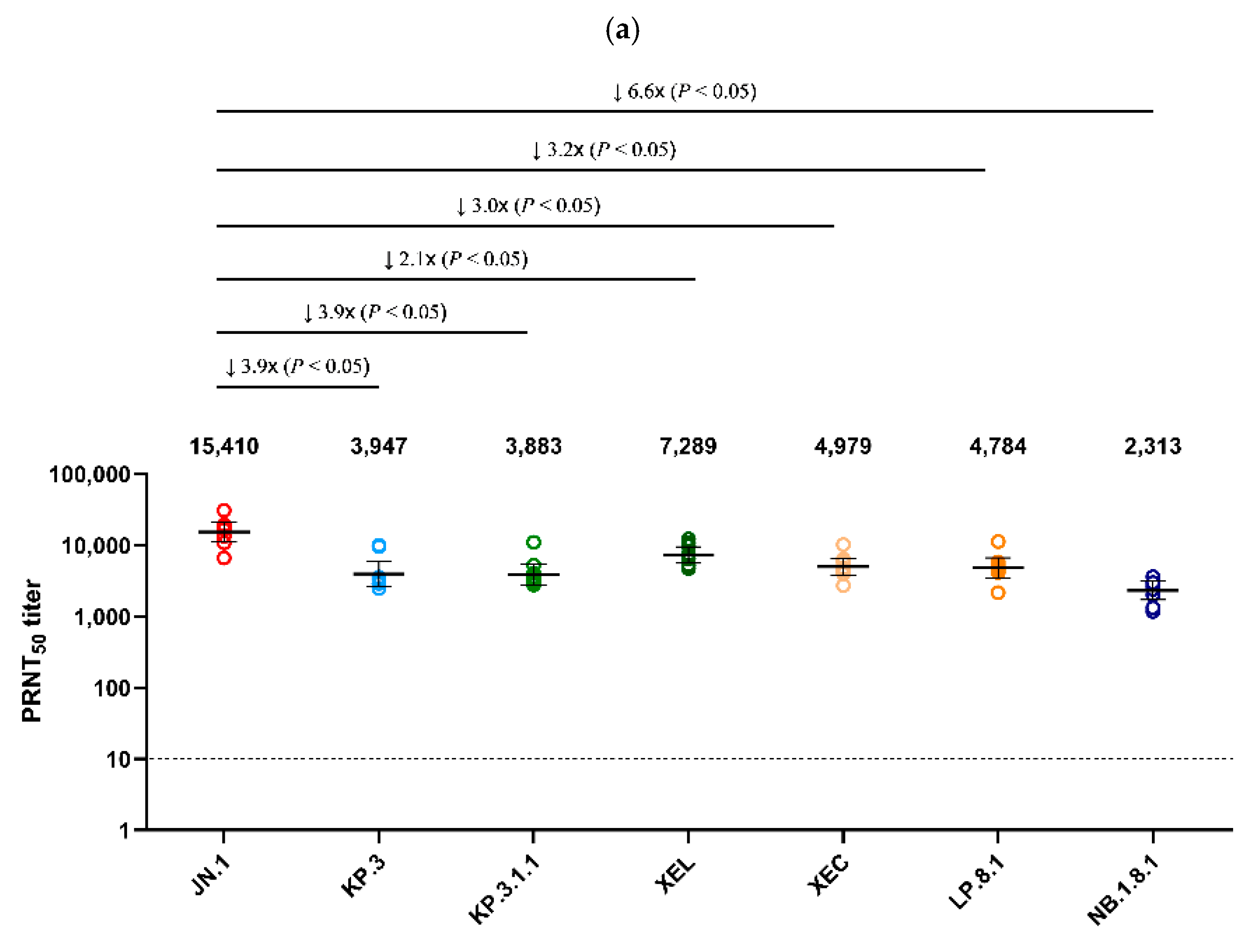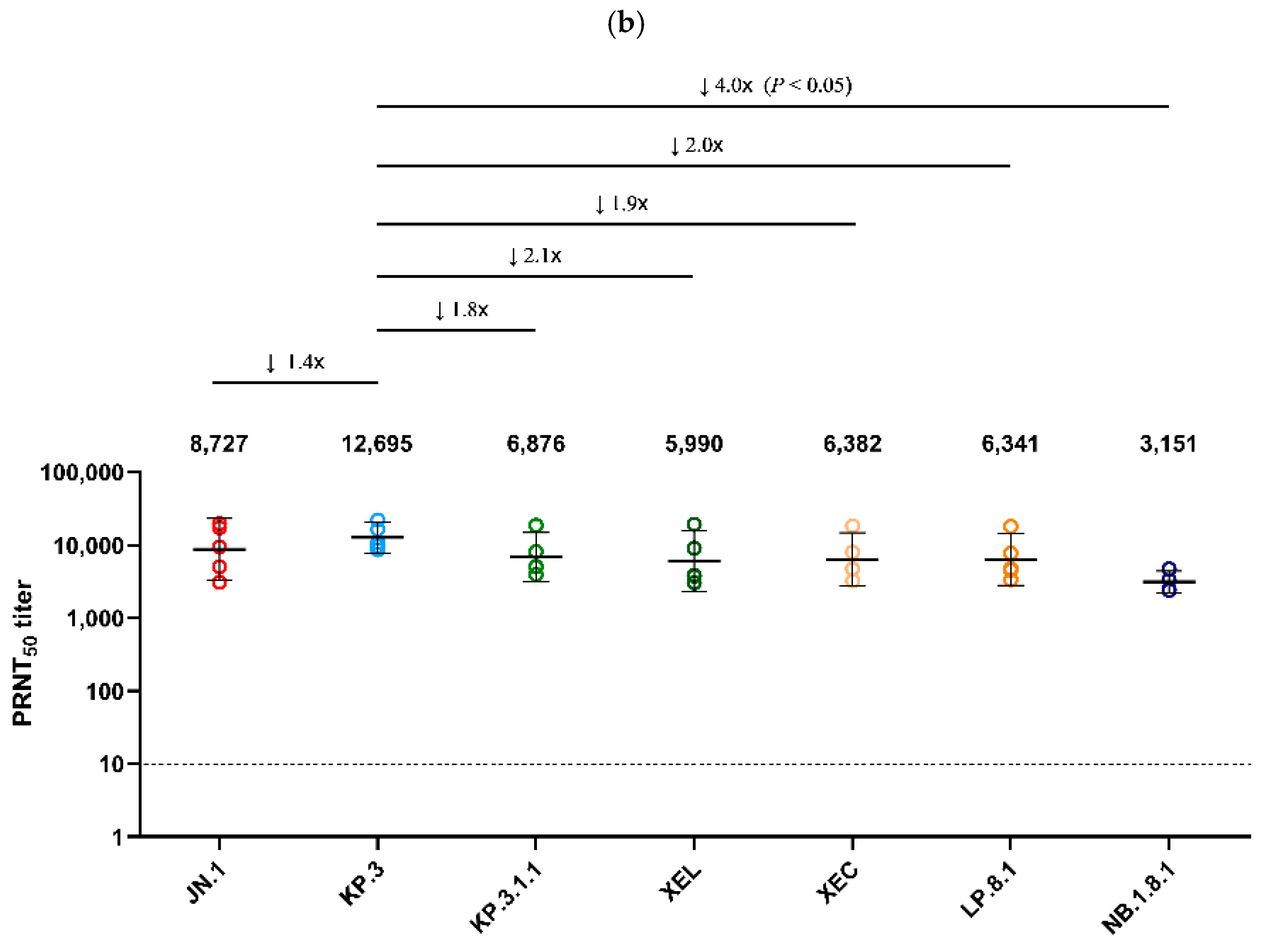Long-Term Genomic Surveillance and Immune Escape of SARS-CoV-2 in the Republic of Korea, with a Focus on JN.1-Derived Variants
Abstract
1. Introduction
2. Materials and Methods
2.1. Clinical Specimens and RNA Extraction
2.2. Whole-Genome Sequencing
2.3. Genetic Diversity Analysis
2.4. Phylogenetic Analysis
2.5. Virus Isolation
2.6. Animal Study
2.7. Plaque Reduction Neutralization Test
3. Results
3.1. Distribution of Variants in the Republic of Korea
3.2. Genetic Diversity of Variant Genomes
3.3. Phylogenetic Analysis of Variants
3.4. Plaque Reduction Neutralization Test
4. Discussion
Supplementary Materials
Author Contributions
Funding
Institutional Review Board Statement
Informed Consent Statement
Data Availability Statement
Acknowledgments
Conflicts of Interest
Abbreviations
| COVID-19 | coronavirus disease 2019 |
| DMEM | Dulbecco’s modified Eagle’s medium |
| GMT | geometric mean titer |
| KDCA | Korean Disease Control and Prevention Agency |
| K-RISS | Korean Respiratory Virus Integrated Surveillance System |
| PFU | plaque-forming units |
| PRNT50 | 50% plaque reduction neutralization titer |
| RT-PCR | real-time reverse transcriptase-polymerase chain reaction |
| SARS-CoV-2 | severe acute respiratory syndrome coronavirus 2 |
| VOC | variant of concern |
| WHO | World Health Organization |
References
- Zhu, N.; Zhang, D.; Wang, W.; Li, X.; Yang, B.; Song, J.; Zhao, X.; Huang, B.; Shi, W.; Lu, R.; et al. A novel coronavirus from patients with pneumonia in China, 2019. N. Engl. J. Med. 2020, 382, 727–733. [Google Scholar] [CrossRef]
- Cucinotta, D.; Vanelli, M. WHO declares COVID-19 a pandemic. Acta Biomed. 2020, 91, 157–160. [Google Scholar] [CrossRef]
- World Health Organization. COVID-19 Epidemiological Update Edition 177 Published 2025. Available online: https://www.who.int/publications/m/item/covid-19-epidemiological-update-edition-177 (accessed on 9 July 2025).
- World Health Organization. Statement on the Fifteenth Meeting of the IHR Emergency Committee Regarding COVID-19 Pandemic. 2023. Available online: https://www.who.int/news/item/05-05-2023-statement-on-the-fifteenth-meeting-of-the-international-health-regulations-(2005)-emergency-committee-regarding-the-coronavirus-disease-(covid-19)-pandemic (accessed on 9 July 2025).
- World Health Organization. Tracking SARS-CoV-2 Variants, Updated 2025. Available online: https://www.who.int/activities/tracking-SARS-CoV-2-variants (accessed on 9 July 2025).
- V’kovski, P.; Kratzel, A.; Steiner, S.; Stalder, H.; Thiel, V. Coronavirus biology and replication: Implications for SARS-CoV-2. Nat. Rev. Microbiol. 2021, 19, 155–170. [Google Scholar] [CrossRef] [PubMed] [PubMed Central]
- Singh, J.; Pandit, P.; McArthur, A.G.; Banerjee, A.; Mossman, K. Evolutionary trajectory of SARS-CoV-2 and emerging variants. Virol. J. 2021, 18, 166. [Google Scholar] [CrossRef] [PubMed] [PubMed Central]
- Andre, M.; Lau, L.S.; Pokharel, M.D.; Ramelow, J.; Owens, F.; Souchak, J.; Akkaoui, J.; Ales, E.; Brown, H.; Shil, R.; et al. From Alpha to omicron: How different variants of concern of the SARS-Coronavirus-2 impacted the world. Biology 2023, 12, 1267. [Google Scholar] [CrossRef] [PubMed] [PubMed Central]
- Lu, Y.; Ao, D.; He, X.; Wei, X. The rising SARS-CoV-2 JN.1 variant: Evolution, infectivity, immune escape, and response strategies. MedComm 2024, 5, e675. [Google Scholar] [CrossRef] [PubMed] [PubMed Central]
- World Health Organization. Updated Risk Evaluation of SARS-CoV-2 Variant JN.1. Executive Summary. 2024. Available online: https://www.who.int/docs/default-source/coronaviruse/15042024_jn1_ure.pdf (accessed on 10 July 2025).
- Kim, I.H.; No, J.S.; Kim, J.A.; Park, A.K.; Lee, H.; Kim, J.M.; Lee, N.J.; Kim, C.K.; Lee, C.Y.; Woo, S.; et al. Genomic epidemiology of SARS-CoV-2 variants in South Korea between January 2020 and February 2023. Virology 2023, 587, 109869. [Google Scholar] [CrossRef] [PubMed]
- No, J.S.; Noh, J.Y.; Lee, C.Y.; Kim, I.H.; Kim, J.A.; Ahn, Y.J.; Lee, H.; Kim, J.M.; Lee, N.J.; Lee, D.W.; et al. Dynamics of SARS-CoV-2 variants during the XBB wave in the Republic of Korea. Virus Res. 2024, 350, 199471. [Google Scholar] [CrossRef] [PubMed] [PubMed Central]
- Cao, Y.; Wang, J.; Jian, F.; Xiao, T.; Song, W.; Yisimayi, A.; Huang, W.; Li, Q.; Wang, P.; An, R.; et al. Omicron escapes the majority of existing SARS-CoV-2 neutralizing antibodies. Nature 2022, 602, 657–663. [Google Scholar] [CrossRef] [PubMed] [PubMed Central]
- Harvey, W.T.; Carabelli, A.M.; Jackson, B.; Gupta, R.K.; Thomson, E.C.; Harrison, E.M.; Ludden, C.; Reeve, R.; Rambaut, A.; COVID-19 Genomics UK (COG-UK) Consortium; et al. SARS-CoV-2 variants, spike mutations and immune escape. Nat. Rev. Microbiol. 2021, 19, 409–424. [Google Scholar] [CrossRef] [PubMed] [PubMed Central]
- Sia, S.F.; Yan, L.M.; Chin, A.W.H.; Fung, K.; Choy, K.T.; Wong, A.Y.L.; Kaewpreedee, P.; Perera, R.A.P.M.; Poon, L.L.M.; Nicholls, J.M.; et al. Pathogenesis and transmission of SARS-CoV-2 in golden hamsters. Nature 2020, 583, 834–838. [Google Scholar] [CrossRef] [PubMed] [PubMed Central]
- Rössler, A.; Mühlemann, B.; Netzl, A.; Riepler, L.; Bante, D.; Richter, F.; Wimmer, N.; Hochenburger, R.; Puchhammer-Stöckl, E.; Allerberger, F. Direct comparison of SARS-CoV-2 variant-specific neutralizing antibodies in human and hamster sera. npj Vaccines 2024, 9, 88. [Google Scholar] [CrossRef] [PubMed] [PubMed Central]
- Li, W.; Godzik, A. Cd-hit: A fast program for clustering and comparing large sets of protein or nucleotide sequences. Bioinformatics 2006, 22, 1658–1659. [Google Scholar] [CrossRef]
- Librado, P.; Rozas, J. DnaSP v5: A software for comprehensive analysis of DNA polymorphism data. Bioinformatics 2009, 25, 1451–1452. [Google Scholar] [CrossRef]
- Korea Disease Control and Prevention Agency. Change of COVID-19 Surveillance System Following Reclassification as a Class 4 Infectious Disease on 31 August 2023. 2023. Available online: https://kdca.go.kr/board/board.es?act=view&bid=0015&cg_code=&list_no=723304 (accessed on 9 July 2025).
- Hwang, H.; Lee, W.; Ahn, S.; Choi, Y.S.; Kwon, S.L.; Lee, D.; Choi, E.H.; Lee, S.G. Implementation plan for the coronavirus disease 2019 vaccination for the 2024–2025 season: Recommendations of the 6th expert committee on immunization practices. Public Health Wkly. Rep. 2025, 18, 90–102. [Google Scholar] [CrossRef]
- Kim, J.; Choe, Y.J.; Jang, E.J.; Lim, D.S.; Kim, Y.Y.; Kim, R.K.; Yi, S.; Lee, S.; Park, Y.J. Effectiveness of booster mRNA vaccines against SARS-CoV-2 infection in an elderly population, South Korea, October 2021–January 2022. Clin. Infect. Dis. 2022, 75, 920–921. [Google Scholar] [CrossRef]
- Korea Disease Control and Prevention Agency. Winter Season COVID-19 Booster Using BA.1-Based Bivalent Vaccine Begins. 2022. Available online: https://www.kdca.go.kr/board/board.es?mid=a20501010000&bid=0015&list_no=720874 (accessed on 9 July 2025).
- Korea Disease Control and Prevention Agency. Pfizer, BA.4/5-Based Bivalent COVID-19 Vaccine Rollout Begins 14 November 2022. 2022. Available online: https://www.kdca.go.kr/board/board.es?mid=a20603000000&bid=0015&list_no=721104 (accessed on 9 July 2025).
- Korea Disease Control and Prevention Agency. Discontinuation of BA.4/5 Bivalent COVID-19 Vaccines and Transition to XBB.1.5 Monovalent Boosters from 19 October 2023. 2023. Available online: https://www.kdca.go.kr/board/board.es?mid=a20501010000&bid=0015&list_no=723542 (accessed on 9 July 2025).
- Korea Disease Control and Prevention Agency. National COVID-19 Seasonal Vaccination Program Using JN.1 Vaccine Begins 10 October 2024. 2024. Available online: https://nip.kdca.go.kr/irhp/covd/goCov19Vcnt.do?menuCd=47&menuLv=4 (accessed on 9 July 2025).
- Kim, J.M.; Chung, Y.S.; Jo, H.J.; Lee, N.J.; Kim, M.S.; Woo, S.H.; Park, S.; Kim, J.W.; Kim, H.M.; Han, M.G. Identification of coronavirus isolated from a patient in Korea with COVID-19. Osong Public Health Res. Perspect. 2020, 11, 3–7. [Google Scholar] [CrossRef]
- Korea Disease Control and Prevention Agency. All About Korea’s Response to COVID-19. 2020. Available online: https://www.kdca.go.kr/upload_comm/syview/doc.html?fn=160276224199800.pdf&rs=/upload_comm/docu/0030/ (accessed on 9 July 2025).
- Hong, J.; Park, A.K.; Radnaabaatar, M.; Kim, E.J.; Kim, D.W.; Jung, J. The impact of entry restrictions on the spread of severe acute respiratory syndrome coronavirus variants between 2021 and 2022. J. Korean Med. Sci. 2023, 38, e223. [Google Scholar] [CrossRef] [PubMed] [PubMed Central]
- World Health Organization. Statement on the Antigen Composition of COVID-19 Vaccines. 2024. Available online: https://www.who.int/news/item/26-04-2024-statement-on-the-antigen-composition-of-covid-19-vaccines (accessed on 10 July 2025).
- Flores-Alanis, A.; Cruz-Rangel, A.; Rodríguez-Gómez, F.; Gonźalez, J.; Torres-Guerrero, C.A.; Delgado, G.; Cravioto, A.; Morales-Espinosa, R. Molecular epidemiology surveillance of SARS-CoV-2: Mutations and genetic diversity one year after emerging. Pathogens 2021, 10, 184. [Google Scholar] [CrossRef]
- González-Vázquez, L.D.; Arenas, M. Molecular evolution of SARS-CoV-2 during the COVID-19 pandemic. Genes 2023, 14, 407. [Google Scholar] [CrossRef] [PubMed] [PubMed Central]
- Gorbachev, V.V. Effect of random sample size on the accuracy of nucleotide diversity estimation. Russ. J. Genet. 2012, 48, 746–750. [Google Scholar] [CrossRef]
- Wang, W.; Bhushan, G.; Paz, S.; Stauft, C.B.; Selvaraj, P.; Goguet, E.; Bishop-Lilly, K.A.; Subramanian, R.; Vassell, R.; Lusvarghi, S.; et al. Human and hamster sera correlate well in identifying antigenic drift among SARS-CoV-2 variants, including JN.1. J. Virol. 2024, 98, e0094824. [Google Scholar] [CrossRef]
- Guo, C.; Yu, Y.; Liu, J.; Jian, F.; Yang, S.; Song, W.; Yu, L.; Shao, F.; Cao, Y. Antigenic and virological characteristics of SARS-CoV-2 variants BA.3.2, XFG, and NB.1.8.1. Lancet Infect. Dis. 2025, 25, e374–e377. [Google Scholar] [CrossRef]
- Uriu, K.; Okumura, K.; Uwamino, Y.; Chen, L.; Tolentino, J.E.; Asakura, H.; Nagashima, M.; Sadamasu, K.; Yoshimura, K.; Ito, J.; et al. Virological characteristics of the SARS-CoV-2 NB.1.8.1 variant. Lancet Infect. Dis. 2025, 6, E443. [Google Scholar] [CrossRef] [PubMed]
- World Health Organization. WHO TAG-VE Risk Evaluation for SARS-CoV-2 Variant Under Monitoring: NB.1.8.1 [Executive Summary]. 2025. Available online: https://cdn.who.int/media/docs/default-source/documents/epp/tracking-sars-cov-2/23052025_nb.1.8.1_ire.pdf (accessed on 10 July 2025).
- Astakhova, E.A.; Morozov, A.A.; Vavilova, J.D.; Filatov, A.V. Antigenic cartography of SARS-CoV-2. Biochemistry 2024, 89, 862–871. [Google Scholar] [CrossRef] [PubMed]
- US Food and Drug Administration. Considerations for Influenza and COVID-19 Vaccine Strain Selection. In Proceedings of the VRBPAC Meeting Materials: Selection of COVID 19 Vaccine Antigen Strain for 2025–2026 Formula, Online, 22 May 2025; World Health Organization: Geneva, Switzerland, 2025; p. 2024. Available online: https://www.fda.gov/media/186567/download (accessed on 10 July 2025).
- World Health Organization. Statement on the Antigen Composition of COVID-19 Vaccines. 2025. Available online: https://www.who.int/news/item/15-05-2025-statement-on-the-antigen-composition-of-covid-19-vaccines (accessed on 10 July 2025).
- gisaid.org [Internet]. Global Initiative on Sharing all Influenza. Available online: https://www.gisaid.org (accessed on 10 July 2025).





Disclaimer/Publisher’s Note: The statements, opinions and data contained in all publications are solely those of the individual author(s) and contributor(s) and not of MDPI and/or the editor(s). MDPI and/or the editor(s) disclaim responsibility for any injury to people or property resulting from any ideas, methods, instructions or products referred to in the content. |
© 2025 by the authors. Licensee MDPI, Basel, Switzerland. This article is an open access article distributed under the terms and conditions of the Creative Commons Attribution (CC BY) license (https://creativecommons.org/licenses/by/4.0/).
Share and Cite
Kim, I.-H.; Lee, E.J.; No, J.S.; Noh, J.Y.; Lee, C.Y.; O, S.W.; Choi, Y.J.; Kim, J.-A.; An, B.M.; Nam, J.-H.; et al. Long-Term Genomic Surveillance and Immune Escape of SARS-CoV-2 in the Republic of Korea, with a Focus on JN.1-Derived Variants. Viruses 2025, 17, 1202. https://doi.org/10.3390/v17091202
Kim I-H, Lee EJ, No JS, Noh JY, Lee CY, O SW, Choi YJ, Kim J-A, An BM, Nam J-H, et al. Long-Term Genomic Surveillance and Immune Escape of SARS-CoV-2 in the Republic of Korea, with a Focus on JN.1-Derived Variants. Viruses. 2025; 17(9):1202. https://doi.org/10.3390/v17091202
Chicago/Turabian StyleKim, Il-Hwan, Eun Ju Lee, Jin Sun No, Ji Yeong Noh, Chae Young Lee, Sang Won O, Yong Jun Choi, Jeong-Ah Kim, Bo Min An, Jeong-Hyun Nam, and et al. 2025. "Long-Term Genomic Surveillance and Immune Escape of SARS-CoV-2 in the Republic of Korea, with a Focus on JN.1-Derived Variants" Viruses 17, no. 9: 1202. https://doi.org/10.3390/v17091202
APA StyleKim, I.-H., Lee, E. J., No, J. S., Noh, J. Y., Lee, C. Y., O, S. W., Choi, Y. J., Kim, J.-A., An, B. M., Nam, J.-H., Kim, J.-M., Rhee, J. E., & Kim, E.-J. (2025). Long-Term Genomic Surveillance and Immune Escape of SARS-CoV-2 in the Republic of Korea, with a Focus on JN.1-Derived Variants. Viruses, 17(9), 1202. https://doi.org/10.3390/v17091202





